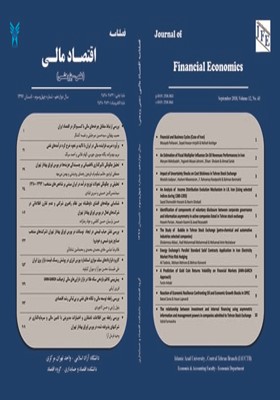بررسی ارتباط متقابل چرخههای مالی با کسبوکار در اقتصاد ایران
محورهای موضوعی : اقتصاد مالیمصیب پهلوانی 1 , سید حسین میر جلیلی 2 , نفیسه کشتگر 3
1 - دانشیار اقتصاد، دانشگاه سیستان و بلوچستان، سیستان و بلوچستان، ایران.
2 - دانشیار اقتصاد، عضو هیات علمی پژوهشگاه علوم انسانی و مطالعات فرهنگی، تهران، ایران.
3 - دانشجوی دکتری اقتصاد دانشگاه سیستان و بلوچستان، سیستان و بلوچستان، ایران.
کلید واژه: G01, فیلتر کالمن, E32, واژههای کلیدی: مدل سری زمانی ساختاری چندمتغیره, برآورد حداکثر راستنمایی, چرخههای کوتاهمدت و میانمدت. طبقه بندی JEL : C32,
چکیده مقاله :
در این مقاله با استفاده از یک مدل سری زمانی ساختاری چند متغیره شامل چهار متغیر کلیدی اقتصاد کلان و مالی، رابطه بین این متغیرها را در چرخه های کوتاه مدت و میان مدت برای اقتصاد ایران بدست می آوردیم. جنبه جدید رویکرد مورد استفاده این است که از طریق چرخه های برآورد شده، پویایی های کوتاه مدت و میان مدت این متغیرها تجزیه می شود. نتایج پژوهش نشان می دهد که حرکات چرخه ای حجم اعتبار و وام مسکن به طور عمده تحت تاثیر چرخه میان مدت است، در حالی که حرکات چرخه ای متغیرهای اقتصاد کلان تحت تاثیر چرخه کوتاه مدت و میان مدت قرار دارد. همچنین، حرکت مشترک بین چرخه های متغیرهای مالی و اقتصاد کلان، عمدتاً در میان مدت وجود دارد. از سوی دیگر هم چرخه ای قوی میان چرخه های کوتاه مدت تولید ناخالص داخلی و تولید صنعتی مشاهده می شود. به همین جهت چرخه کوتاه مدت تولید صنعتی، تقریب خوبی برای چرخه کوتاه مدت تولید ناخالص داخلی است. همین طور هم چرخه ای قابل توجهی میان اعتبارات و تولید ناخالص داخلی در میان مدت وجود دارد. این نتیجه از این ایده حمایت می کند که نوسانات میان مدت در تولید ناخالص داخلی تا حدی ناشی از الگوی رونق- رکود در اعتبار است. بنابراین تحلیل نشان می دهد که، توجه به روابط متقابل میان چرخه ها، هنگام طراحی سیاست های تنظیمی به منظور اطمینان از سلامت کل سیستم، ضروری است. Abstract In this paper, by using a multivariate structural time series model including four key macroeconomic and financial variables of Iran, we devised short and medium term cycles for Iran's economy. The new aspect of the approach is that through the estimated cycles, the short and medium dynamics of these variables are decomposed. The results indicated that cyclic movements of credit and mortgage volumes are mainly influenced by the medium-term cycle, while cyclical movements of macroeconomic variables are affected by the short-term and medium-term cycles. Also, there is a co-movement between the cycles of financial variables and macroeconomics, mainly in the medium term. On the other hand, there is a strong co-cyclicality between the short-term cycles of GDP and industrial production. Therefore, the short-term industrial production cycle is a good approximation to the short-run GDP cycle. There is a significant co-cyclicality between credits and GDP in the medium term. This result supports the idea that the medium-term fluctuations in GDP are partly due to the boom-bust pattern in credit. There is also a strong indirect co-cyclicality between the mid-term GDP and mortgage cycles.
فهرست منابع
1) طیبنیا، علی و قاسمی، فاطمه (1389)، اندازهگیری چرخههای تجاری در ایران، مجله تحقیقات اقتصادی، شماره92، 183-206.
2) گلخندان، ابوالقاسم (1394)، چرخههای تجاری اقتصاد ایران طی دوره 1389-1368، فصلنامه تحقیقات توسعه اقتصادی، شماره17، 104-83.
3) هادیان، ابراهیم و هاشم پور، محمدرضا (1382)، شناسایی چرخههای تجاری در اقتصاد ایران، فصلنامه پژوهشهای اقتصادی ایران، شماره15، 93-120.
4) Borio, C. (2012). The financial cycle and macroeconomics: What have we learnt?, Bank for International Settlements, No 395.
5) Claessens, S. & Kose, M. A. & Terrones, M. E. (2011a). How Do Business and Financial Cycles Interact?, IMF Working Paper.
6) Claessens, S. & Kose, M. A. & Terrones, M. E. (2011b). Financial Cycles: What? How? When?, International Monetary Fund working paper.
7) Farrell, G. & Kemp E. (2017). Measuring the Financial Cycle in South Africa.
8) Mendelssohn, R. (2011). The STAMP for state space models. Journal of statistical software. Vol. 41:2.
9) Pontines, V. (2016). The Financial Cycles in four East Asian Economies, Working Paper The South East Asian Central banks Research and Training Centre Kuala Lumour, Malaysia.
10) Comin, D. & Gertler, M. (2006). Medium-term business cycles, American Economic Review, 96(3): 523-551.
11) Comin, D. & Loayza, N. & Pasha, F., & Serven, L. (2014). Medium term business cycles in development countries, American Economic Journal: Macroeconomics, 6(4):209-45.
12) Koopman, S. J. & Lucas, A. (2005). Business and default cycles for credit risk, Journal of Applied Econometrics, 20(2):311-323.
13) Harvey, A. C. & Koopman, S. J. (1997). "Multivariate Structural time series models". In Heij, C., Schumacher, H., Hanzon, B., and Praagman, C., editors, System Dynamics in Economic and Financial Models. John Wiley and Sons.
14) Correa-Lopez, M. & de Blas, B. (2012). International transmission of medium- term technology cycles: evidence from Spain as a recipient country, The B. E. Journal of Macroeconomics, Vol. 12:1, pp:1-52.
15) Winter, J. & Koopman, S. J. & Hindrayanto, I. & Chouhan, A. (2017). Modeling the business and financial cycle in a multivariate structural time series model, De Nederlandsche Bank NV, Working Paper No.573
یادداشتها

